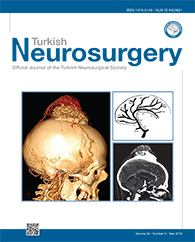2Sichuan University, West China Hospital, Department of Radiology, Chengdu, Sichuan, China
3Sichuan University, West China Hospital, Department of Infectious Disease, Chengdu, Sichuan, China DOI : 10.5137/1019-5149.JTN.11672-14.1 AIM: To investigate the indications and clinical value of the surgical therapy of neurocysticercosis (NCC).
MATERIAL and METHODS: We retrospectively reviewed all 10 patients with NCC treated surgically from January 2009 to January 2014 in our institute. The NCC types included parenchymal cysticerci in 6 cases, subarachnoid cysticerci in 3 and ventricular cysticerci in 1.
RESULTS: All 10 patients underwent resection of cysticerci through craniotomy. Parenchymal NCC included an isolated lesion in 4 cases and multi-lesions in 2 cases, who respectively had coexistence of metastasis and cysticerci and a positive history of tuberculosis. In all 3 patients with arachnoid NCC, two cases underwent lesion resection and the other one underwent cyst resection and lamina terminalis fenestration. In one case with intraventricular NCC, a ventriculoperitoneal (VP) shunt was placed as the initial treatment. Due to failure of the shunt, the secondary surgery of cyst excision via open craniotomy and VP shunt placement were performed simultaneously.
CONCLUSION: For parenchymal cysticercosis, the surgical aim is to remove the lesion, treat the medically intractable epilepsy, and establish the diagnosis and subsequent treatment. As for extraparenchymal NCC, surgical therapy is a valuable treatment as an alternative due to its fatal complications. For subarachnoid cysticercosis, because of its higher failure rate in simply VP shunt, the open craniotomy could directly remove the cyst and efficaciously relieve hydrocephalus. For the patient with intraventricular NCC associated with hydrocephalus, the effect of a simple VP shunt seems unsatisfactory, and craniotomy for cyst resection is necessary.
Keywords : Neurosurgery, Cysticercosis, Central nervous system




